
ACT Science Practice Test 35
Đề thi nằm trong bộ sưu tập: Tuyển Tập Bộ Đề Thi Đại Học Hoa Kỳ (ACT) - Có Đáp Án Chi Tiết
Số câu hỏi: 23 câuSố mã đề: 1 đềThời gian: 1 giờ
206,717 lượt xem 15,895 lượt làm bài
Xem trước nội dung:
The most common type of red-green color perception defect is caused by a mutation on the X chromosome. X-linked red color blindness is a recessive trait. The eggs of the mother will contain either a normal X chromosome (XR) or an X chromosome with the mutation (Xr) causing red-green color blindness. The sperm of the father will contain the normal X chromosome, the X chromosome with the mutation, or the Y chromosome. Females heterozygous (one normal gene, one mutated gene) for this trait have normal vision. The color perception defect manifests itself in females only when it is inherited from both parents. By contrast, males inherit their sole X chromosome from their mothers, and become red-green color blind when this one X chromosome has the color perception defect.
Genotype refers to the combination of alleles that an individual has for a gene. Table 1 lists the possible genotypes for red-green color perception and their corresponding effects on vision.
Table 1
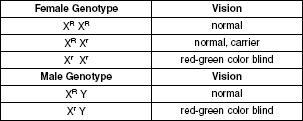
Students interviewed members of the Allen family to investigate the inheritance of red-green color blindness.
Figure 1 displays the family tree of the Allen family.

Figure 1
Study 1
Students interviewed Barbara and John and learned that Barbara is red-green color blind, while John is not. Based on this information, the students deduced that their four children have the following genotypes:

Figure 2
Study 2
Students assumed that Liz would have children with a man who has normal vision, and using a Pundit square calculated all of the possible genotypes for their children:

Figure 3
Study 3
Students assumed that David would have children with a woman who has red-green color blindness, and using a Pundit square calculated all of the possible genotypes for their children:

Figure 4
A female who has normal vision but is a carrier of red-green color blindness must have which of the following genotypes?
XRR
XRr
Xrr
XR
For a couple to produce only red-green colorblind children, regardless of the child’s sex, they would need to have which of the following pairs of genotypes?
XRRr
XrrR
XRrr
Xrrr
All of the male offspring exhibited red-green color blindness in Studies:
1 and 3.
1, 2, and 3.
2 and 3.
1 and 2.
Suppose that the students who worked on Study 2 are correct, and that Liz has children with a man who has normal vision. If they have 8 children, how many of them would be expected to have red-green color blindness?
1
2
4
8
The ratio of Barbara and John’s offspring with normal vision to offspring with red-green color blindness is:
1:2
2:1
1:1
3:1
Barbara’s parents could have had which of the following pairs of genotypes?
XrrR
XRrr
XRRr
XRRR
Crude oil contains many different types of carbons. Different carbon chain lengths have different boiling points, so they can be separated using distillation—the process of boiling and then condensing a liquid in order to separate and purify its components (see Figure 1).
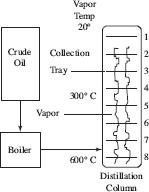
Figure 1
Crude oil is put into a boiler. The boiler is connected to a distillation column filled with collection trays. As the heated oil boils, the vapors released enter the distillation column and rise to the top. When a substance in the vapor reaches a height where the temperature of the column is equal to that substance’s boiling point, it will condense to form a liquid. The liquid is gathered on the collection trays.
Experiment 1
Students determined the boiling points of various components of crude oil by recording the temperature of the vapor at various heights in the distillation column, then determining which component was collected in each of the eight collection trays. See Table 1 and Table 2.
Table 1
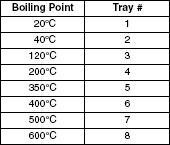
Table 2
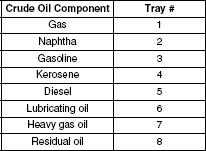
The students distilled one barrel of crude oil. Figure 2 shows the breakdown of that barrel, in terms of which components were collected.
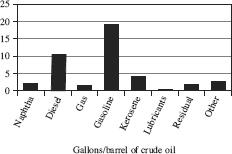
Figure 2
Experiment 2
Students determined the number of carbons in each component of crude oil and recorded the data in Table 3.
Table 3
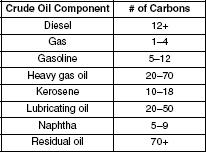
Based on the results of Experiment 1, the boiling temperature of Naphtha is:
20°C
40°C
120°C
200°C
According to the results of Experiment 1, one barrel of crude oil contains about how many gallons of diesel?
2
6
11
29
One of the students hypothesized that the components of crude oil with the highest boiling points would be collected at the top of the distillation column. Do the results of Experiment 1 support the student’s claim?
No. As the vapor rose in the distillation column, the temperature cooled, so the components with the lowest boiling points were collected at the top of the column.
No. There was no correlation between boiling point and location in the distillation column.
Yes. Gasoline and diesel had the highest boiling points, and they were collected in the top two trays.
Yes. The lower the collection tray was in the distillation column, the lower the component’s boiling point.
A scientist claimed that the more carbons a substance has, the higher its boiling point will be. Do the results of Experiment 1 and Experiment 2 support this claim?
No. There is no relationship between the number of carbons and the boiling point.
No. Diesel has more carbons than gasoline, yet its boiling point is lower.
Yes. Residual oil has the most carbons and the lowest boiling point, whereas gas has the fewest carbons and the highest boiling point.
Yes. Residual oil has the most carbons and the highest boiling point, whereas gas has the fewest carbons and the lowest boiling point.
Which of the following components of crude oil has the highest boiling point?
Naphtha
Kerosene
Heavy gas oil
Diesel
The data in Table 1 and Figure 2 support which of the following?
Components with the highest boiling points are collected in greatest quantity.
Components with the lowest boiling points are collected in greatest quantity.
Components with medium boiling points are collected in greatest quantity.
Components with higher boiling points are collected in the same quantities as those with medium boiling points.
Solubility refers to the ability of one substance, the solute, to dissolve in another (the solvent). The balance of molecules between the solvent and the solute determines the solubility of one substance in another. Factors such as temperature and pressure will alter this balance, thus changing the solubility.
Experiments to determine the solubility of methane and carbon dioxide in polyamide (PA-11) were performed in the temperature range 50–90°C, and the pressure range 50–150 atm for methane and 20–40 atm for carbon dioxide. Table 1 displays the solubility (sol) of methane in PA-11. Table 2 shows the solubility (sol) of carbon dioxide in PA-11.
Solubility = (g gas/g PA-11) × 103
Table 1—Methane

Table 2—Carbon Dioxide

Figure 1 shows the pressurization cycle for methane at 100 atm and 50°C. The mass gain divided by the net polyamide mass determines the solubility of the gas.
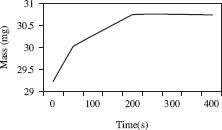
Figure 1
Which of the following substances did NOT become more soluble as pressure increased?
Methane at 70°C
Methane at 50°C
Carbon dioxide at 50°C
Carbon dioxide at 90°C
According to Table 2, at which temperature was carbon dioxide the most soluble under pressure of 31.1 atm?
50°C
70°C
90°C
100°C
Figure 1 supports which of the following claims about polyamide mass gain over time?
The polyamide steadily gained mass.
The polyamide lost mass over time.
The polyamide gained mass at first, and then lost mass.
The polyamide quickly gained mass and then leveled off.
If the experiment was repeated at a temperature of 90°C and a pressure of 80 atm, the solubility of methane would be closest to:
2.61 atm.
3.75 atm.
5.08 atm.
14.0 atm.
Based on the results shown in Table 2, which of the following conclusions can be drawn regarding the relationship between pressure and solubility?
Solubility increases with pressure only above 70°
As pressure increases, solubility decreases.
As pressure increases, so does solubility.
There is no correlation between pressure and solubility.
In this experiment, which substance functioned as the solvent?
Methane
Carbon dioxide
Mass
Polyamide
As shown in Figures 1 and 2, the composition of soil varies by zone. Scientists wanted to determine which types of prairie plants grew best in which zones. To accomplish this, they visited prairies in Zone 3 and in Zone 4 and determined average plant height and root depth (see Table 1). They also looked at several 1-acre plots in both Zone 3 and Zone 4, and recorded the average number of each type of plant found (see Figure 3).
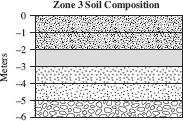
Figure 1
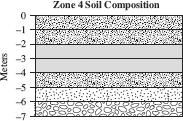
Figure 2

Table 1
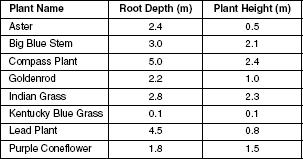

Figure 3
In which zone is clay found at a depth of –3.5m?
Zone 3
Zone 4
Zones 3 and 4
Neither Zone 3 nor 4
Of the prairie plants studied, which had the tallest average plant height?
Aster
Kentucky Blue Grass
Indian Grass
Compass Plant
Based on the data in Figure 3, which of the following can be concluded about the prevalence of plants per zone?
The prairie plants studied grow more easily in Zone 4.
The prairie plants studied grow more easily in Zone 3.
The prairie plants studied grow equally well in Zone 3 and Zone 4.
No conclusion can be drawn about the prevalence of plant growth per zone.
A plant growing in which zone would have roots that reach clay first?
Zone 3
Zone 4
None of the plants studied have roots that would reach clay.
Plants in Zone 3 and Zone 4 would reach clay at the same depth.
The average Lead Plant growing in Zone 3 would have roots that, at their deepest point, reach down to which of the following soil layers?
Sandy clay
Clay
Gravel
Bedrock
